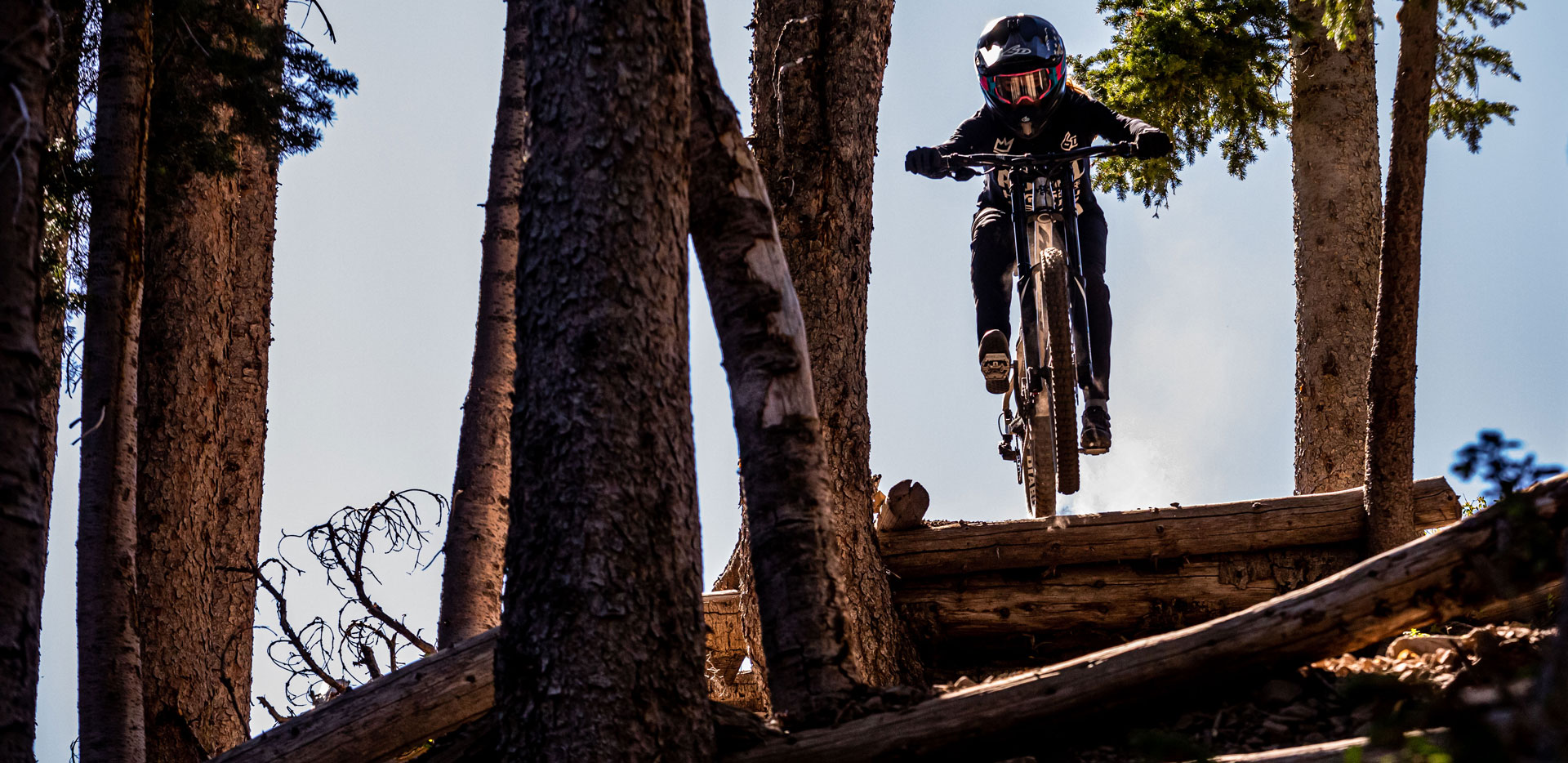
ATHLETE SPOTLIGHT
JORDAN “JORDY” SCOTT
PRESENTED BY SR SUNTOUR
INTRO & PHOTOS BY JP GENDRON
Jordan (Jordy) Scott has been making her way into the mountain biking scene from the BMX world with the same explosive power she displays out of the start gate. Her name is popping up more and more within the circle of the best female mountain bikers in the world. Entering the competitive mountain biking world at 18 years old, Jordy already had a stacked resume of accomplishments from her time racing BMX, including multiple World and National Championship titles. But transitioning from the 20”-wheel battle-royal that is BMX racing into World Cup DH racing and competing at Crankworx is a huge change.
One of Jordy’s main sponsors is Hyper Bikes, a brand that makes both competitive BMX race bikes and mountain bikes. Luckily after Jordy displayed some interest in bigger-wheeled bikes, Hyper was able to get her on some mountain bikes right away, and soon thereafter SR Suntour’s Darren Salsbury’s phone rang with mountain bike legend, Eric Carter on the other end.
As a brand, SR Suntour loves to find and foster up and coming talent as part of our grassroots program. We believe the youth and the next generation of riders deserves attention and support, and when we got word of a young new female rider making noise on the scene, we were excited to connect.
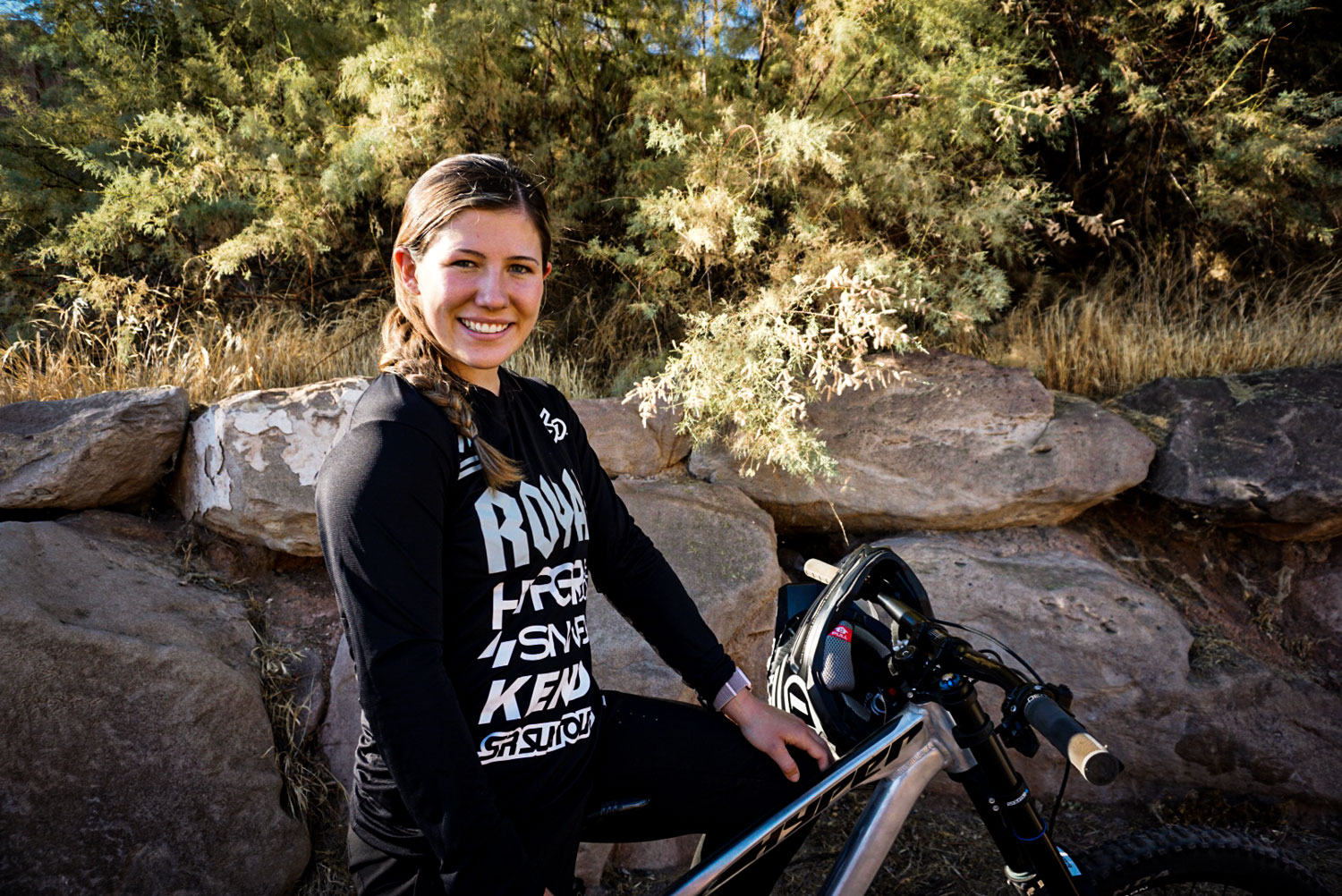
Sponsoring athletes these days is more complicated than ever- the evolving world of social media, YouTube, and whatnot, has more and more riders throwing their hats in the ring for factory attention and sponsorship. This is great really, a sign of the sport expanding and becoming more relevant to more people. The trick from the marketing side is deciding whom to partner with and if they’ll be a positive ambassador for the brand. Obviously as a brand we want to create greater exposure to consumers, find someone that is good to work with, and ultimately create value for us. Being relevant and attractive to a brand for sponsorship can mean so many different things in today’s landscape, being on top of podiums is now only one of many avenues an athlete can take. That being said, when a staple of the sport like E.C. hits you up about a new prospect, you tune in.
Our consensus on bringing Jordy onto the SR Suntour roster was pretty much immediate at that point. This all happened just before Sea Otter ’18, so we scheduled to all meet at the show for the first time. It wasn’t long into the event before the comedic duo of Eric Carter and Mike Miranda, formerly of Hyper Bikes, came strolling through our booth, with a then 17-year old Jordy and her family alongside. It was pretty standard stuff from there on out. We had a great conversation and she was very motivated and excited to jump into competitive mountain biking.
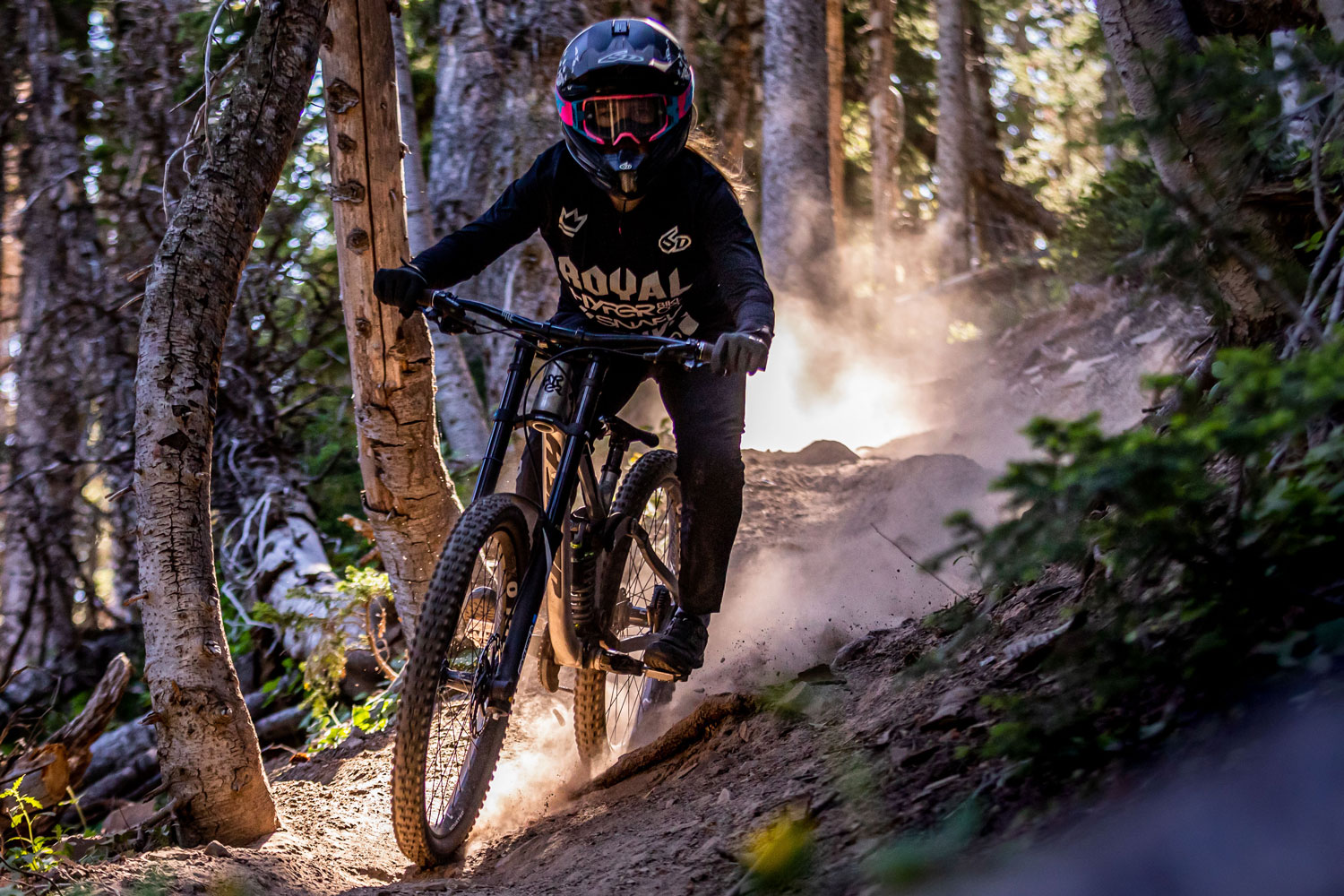
We got Jordy lined up with product and she immediately proceeded to kick ass. Two years later, all signs point to her still just getting started, seen in her performance earlier this year at Crankworx Rotorua, where she took wins in Pump Track and Speed & Style, and currently sits in third for “Queen of Crankworx.”
Needless to say, we’ve been very happy to have Jordy on the SR Suntour roster. We’re excited to be partnered with her, and look forward to continuing to support her growth and career. Beyond her talent on the bike, she’s an awesome, hard working person as she’s simultaneously pursuing a college degree, and a great ambassador for sport to encourage more women and girls to explore mountain biking.
As 2020 has been unprecedented in so many ways, we can only wait and see what the near future looks like for events, races, and projects. Fortunately, Jordy and I both live in the beautiful state of Utah- her in the southern desert, me in the mountainous north. She recently ventured up to ride Woodward Park City and the Deer Valley Resort, right in my backyard. I was able to talk her and her boyfriend Bryce into getting up early to go ride and shoot on one of my favorite trails in the area. It was a gorgeous morning on the ridge line with the summer sun rising quick, and a deep haze drifting across the horizon from multiple not-too-far-off wildfires, providing an orangey-purple hue to the early morning light and dust. We made the most out of a single lap, enjoying the opportunity to shoot, ride together and chat (at safe distance, of course). It was a relieving dose of normalcy in an otherwise overwhelming year.
Cheers, friends. –JP
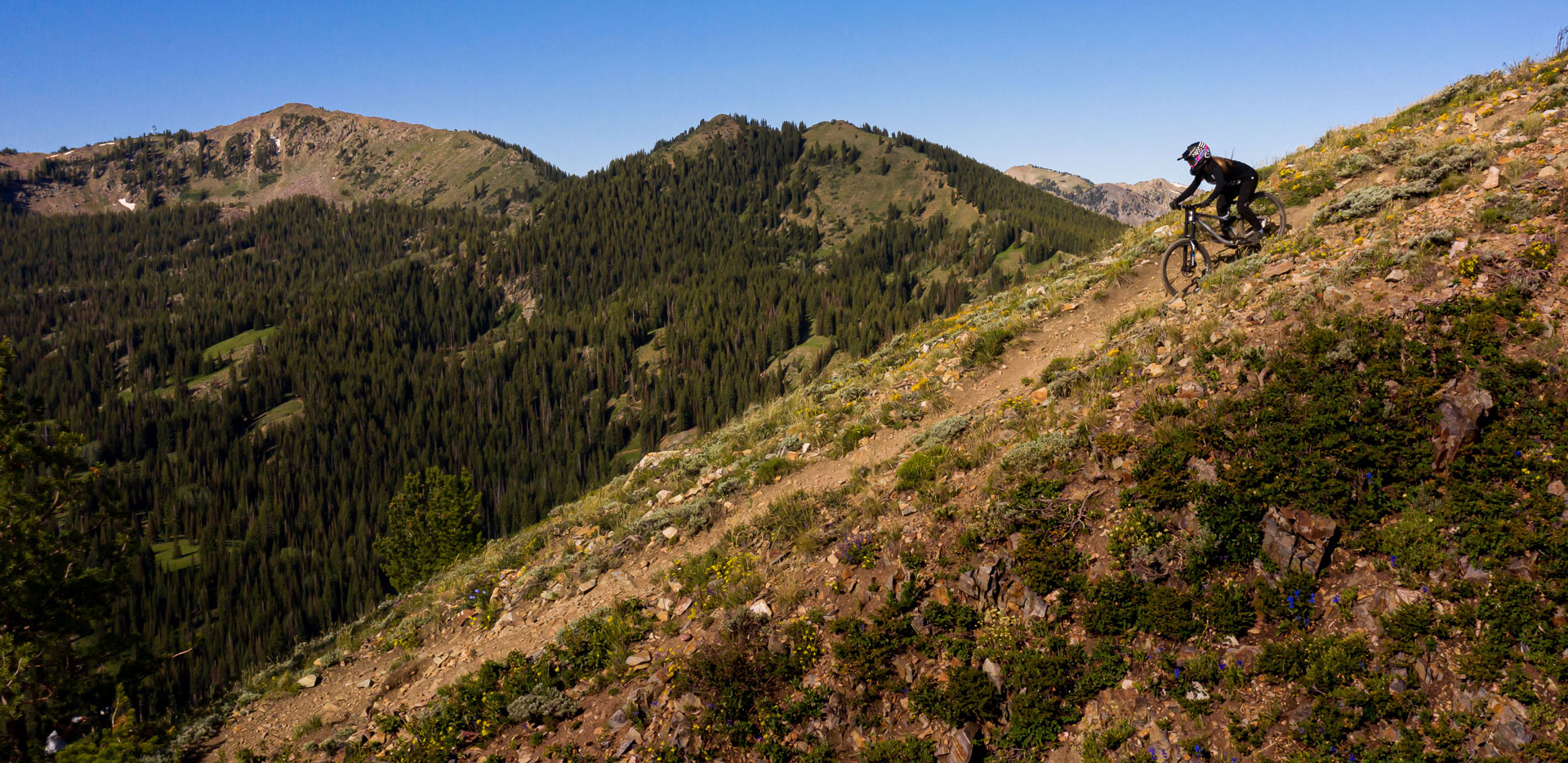
With an intro like that, we wanted to reach out to Jordy ourselves to ask her a few questions and learn more about her transition, goals and impressions of mountain biking compared to growing up racing BMX.
TLW: WHEN YOU WERE RACING BMX, WERE YOU AT ALL AWARE OF MOUNTAIN BIKING, OR WHAT THAT TYPE OF RIDING WAS LIKE?
Jordan Scott: During my BMX years, I had almost always been familiar with the slopestyle side of things because I would go to Woodward West every summer. I loved riding the dirt jumps all week and ended up making friends with many of the current up and coming slopestyle riders like Garret Mechem (Lil Rojo) and Owen Marks (O-bro). I even remember seeing Nicholi the first summer I went. When I was around twelve, I built up my first dirt jumper and went to Woodward for their mountain program instead of BMX; that was a big turning point for me. I spent countless weekends riding at local dirt jump spots after that initial taste of slopestyle and have enjoyed it ever since.
Some people would argue that slopestyle doesn’t truly represent mountain biking, so I’d say my first real experience was at Whistler on the way back from one of the BMX World Championships when I was around fourteen. My dad, brother, and I spent the week up there and went full jerry with the rental gear and all. I can specifically remember going down my first green trail through the trees and having the time of my life; I had never rode something that was longer than thirty seconds long, so the endless trails at Whistler were mind blowing to me. Over the next couple years I found myself following more and more BMXers who had made the transition to mountain biking and enjoyed watching World Cup live streams and the Crankworx events.
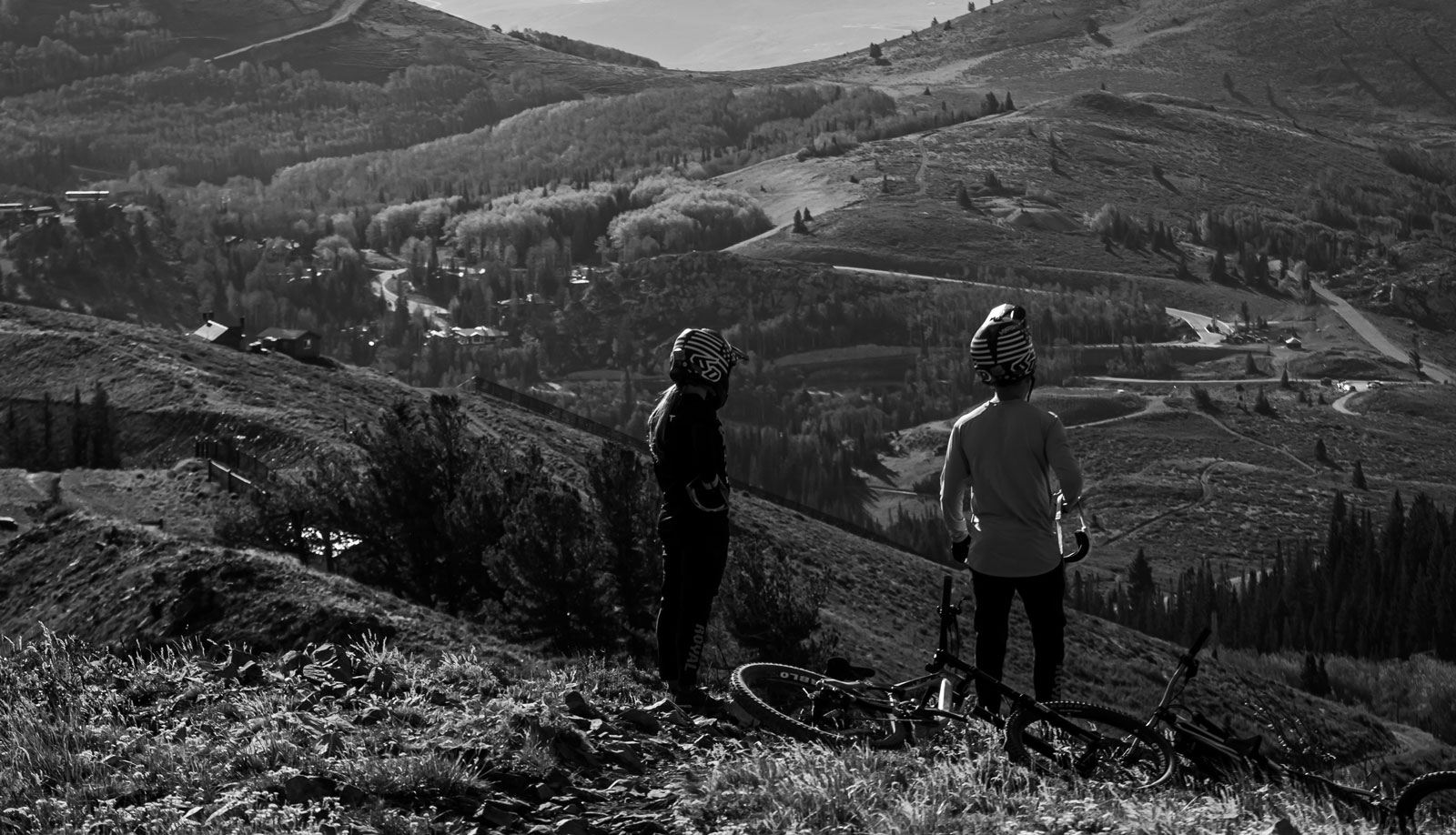
TLW: GROWING UP AT SUCH A COMPETITIVE AND HIGH LEVEL IN BMX, ARE YOU ATTACKING MOUNTAIN BIKING THE SAME WAY, OR IS THIS MORE OF A FUN RACING OUTLET TO KEEP YOU ON THE BIKE AND ENJOYING TWO WHEELS?
JS: My competitive nature makes it almost impossible for me not to put my all into mountain biking and take it seriously, but I definitely think I am having more fun this time around. In BMX, it was difficult for me to progress past a certain point because I felt like it had no value in my actual racing; quad manualing down a straight wasn’t exactly going to help me win races. My absolute favorite thing about mountain biking is how progressive it is, almost every time I get on any of my bikes I learn something new that I can apply to some aspect of my riding.
I definitely have found that I prefer the multi-discipline events over the hard-core World Cup racing, though. I love riding downhill and competing in it at certain events, but I don’t think I will ever find myself at the top of the World Cup circuit. The risk versus reward in committing to downhill racing isn’t worth it for me; I find enjoyment in progressing on all of my bikes.
TLW: WHAT ARE YOUR GOALS WITH YOUR MOUNTAIN BIKE RACING? WHERE DO YOU SEE YOURSELF IN 2-4 YEARS?
JS: In 2-4 years, I hope to see myself competing for the overall in Crankworx, continuing to participate in slopestyle events when possible, and just being a rider that kids and adults can look up to as a strong role model. I also want to grow to be the best partner I can be to the companies that support me. I really want to help grow the community of females in mountain biking and people in general in the cycling world and show them that riding bikes is fun.
My overall goals in mountain bike riding are to progress my riding and myself as a person as much as I can while I am in such a unique situation. I am a full-time college student on an academic scholarship who just moved away from home, and also a professional athlete traveling the world to ride my bike; so there is a lot on my plate but also so much to learn. I love working with companies and building relationships with people all around the world, I feel like I get to experience things I otherwise wouldn’t and I get to grow as a person so much due to it. In order to keep having these awesome experiences, I have to continue to progress on and off my bike.
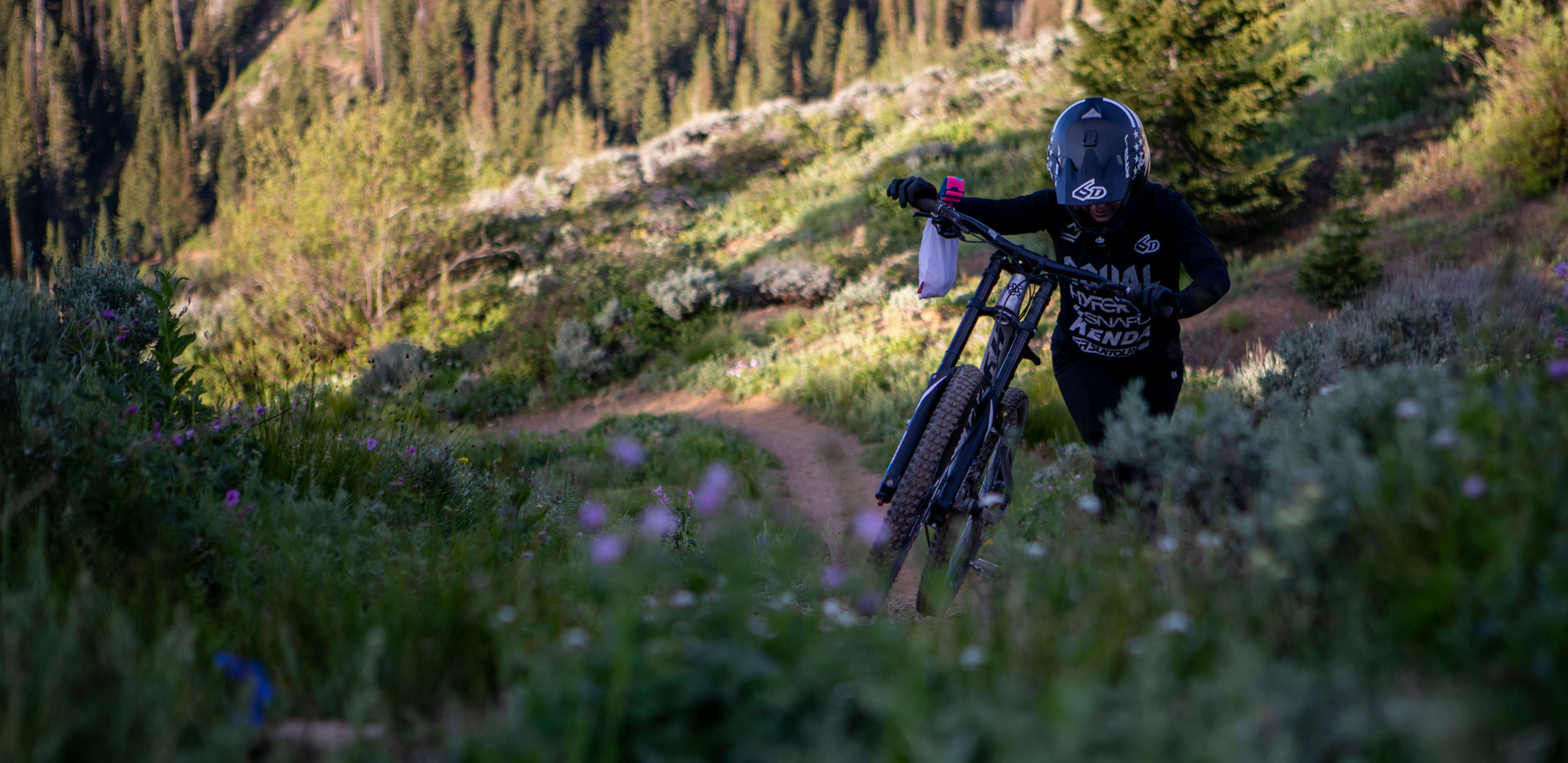
TLW: THE BIO ON YOUR WEBSITE SAYS THAT JUST BEFORE ENTERING THE ADULT DIVISION OF PRO BMX RACING YOU SUFFERED A PRETTY SERIOUS BRAIN INJURY. COULD YOU TELL US ABOUT THAT AND HOW IT’S AFFECTED YOUR CAREER, LIFE AND GOALS AROUND RACING?
JS: That traumatic brain injury was actually the turning point for me that ultimately made me switch from BMX to MTB, so it was a pretty pivotal event in my life. At first, this concussion didn’t seem much different than any of the other ones I had, but when I started to try to ride again things went downhill, no pun intended. The best way I could describe what I was feeling was like having the worst migraine of your life for two weeks straight. I went back to my concussion specialist and was diagnosed with Post Concussion Syndrome (PCS), which is basically the recurring symptoms of a concussion months and even years after it has occurred. These symptoms can be triggered by stress, sickness, or even a seemingly small jolt to the head. Some of the issues I had were loss of taste, lack of peripheral vision, heart rate irregularity, terrible balance, mood changes, lack of motivation, and lots of headaches. I went to physical therapy for 3 months following that diagnosis and was able to get back on my BMX bike for the World Championships where I crashed in the main and got 7th. A couple weeks later, the guys at Hyper asked me if I wanted to come up to Whistler for Crankworx to try out some of the new mountain bikes. I was stoked to go, had an awesome time, and actually got 4th in Pump Track my first year racing it.
After that initial experience of mountain bike competition, I was in a really tough situation. I had been training at the Olympic Training Center for two years prior to the incident, and had my eyes set on turning pro the following year and committing myself to trying to pursue the Olympics in 2020 or 2024. Despite this, many doctors had told me that pursuing BMX at that level was not wise with my head injury due to how risky it is with seven other people on the gate. I made the decision to leave BMX behind and take on mountain biking where if I crash, it is my own fault and I can go at my own pace. I am also sure to wear a helmet that I am confident will keep me as safe as possible at all times, even if I’m just bouncing around in the parking lot.
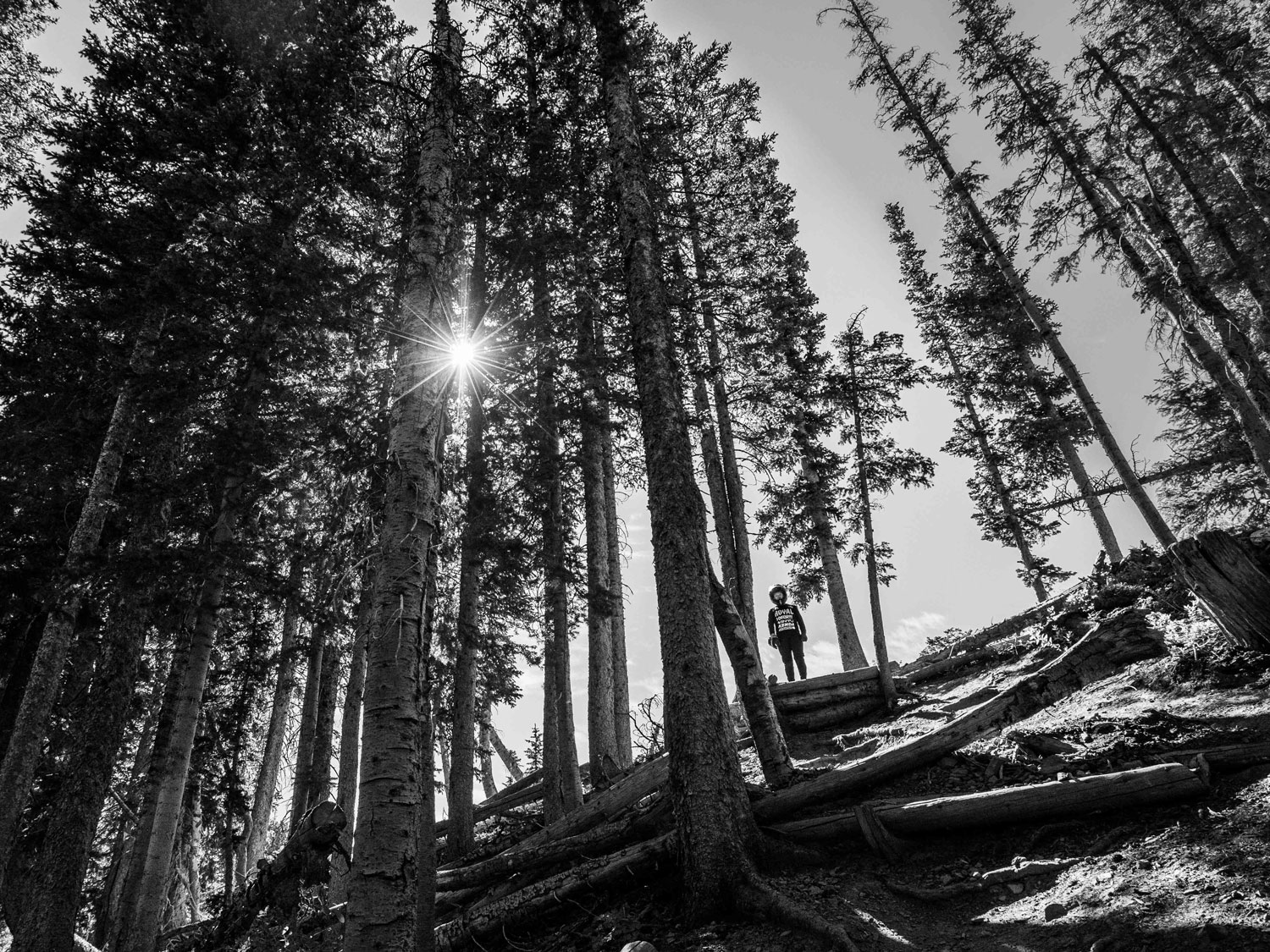
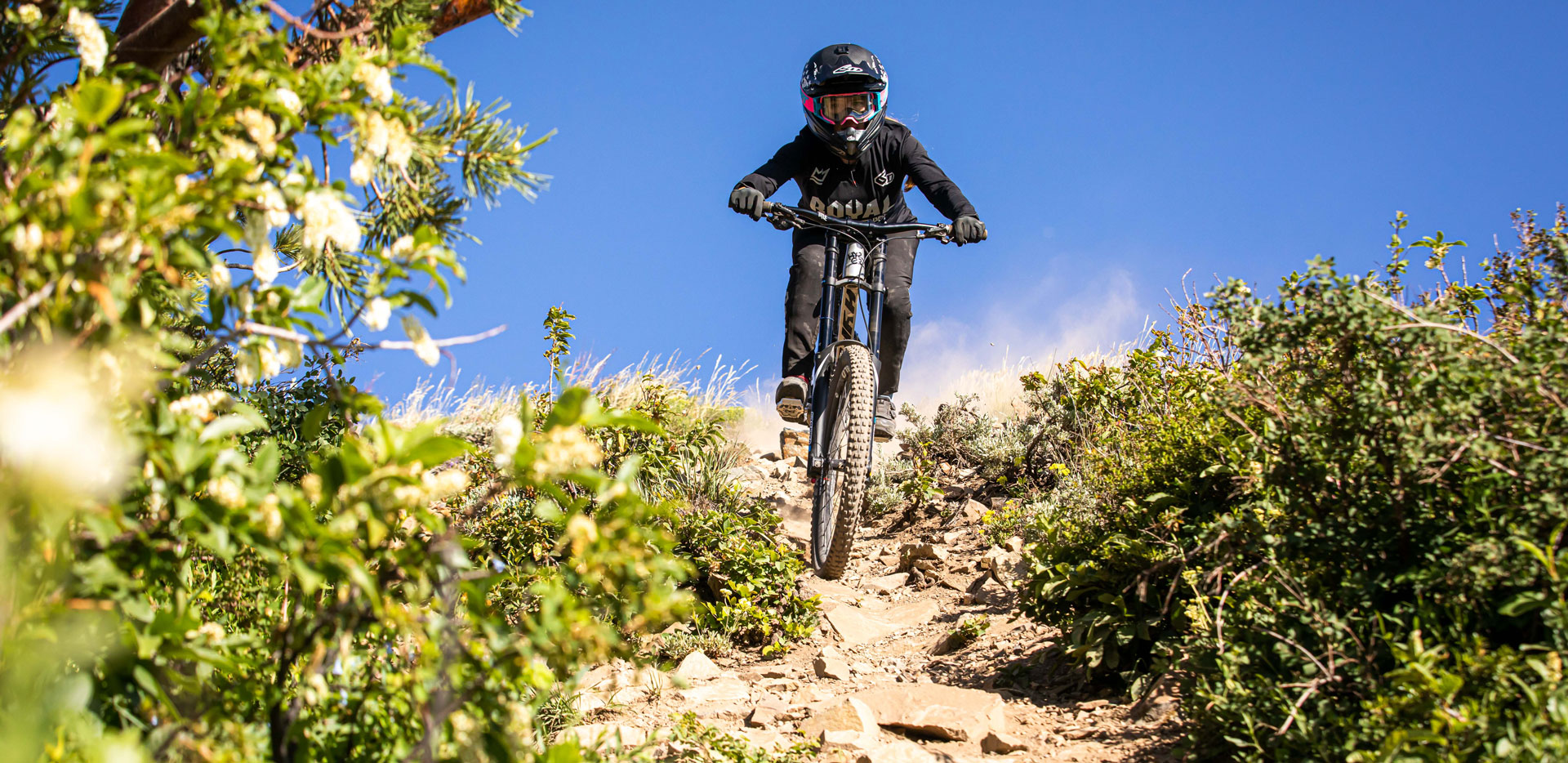
TLW: What has been the biggest struggle in your riding since coming back from that injury?
JS: Surprisingly, my biggest issue since coming back to riding from that injury has been my heart rate. It affected something in my brain called the Vagus nerve and it is supposed to regulate heart rate. My doctors have theorized that my Vagus nerve has the slightest delay, and when my brain realizes this it makes that nerve go haywire and tells my heart rate to speed up when it doesn’t need to. This might not sound like a huge issue, but almost all of my initial physical therapy was spent trying to fix this; my heart rate used to go from 90 sitting down to 150 standing up. We got it as under control as we could, but my heart rate still runs really high and it is nearly impossible for me to do low intensity exercise. It honestly doesn’t affect my riding that much but looking down at my Garmin on a casual trail and seeing my heart rate is at 195 is a little scary. My vision is something I have really struggled with as well since this injury. My prescription doubled and I’ve had to go back to ocular therapy multiple times when things have got out of whack from being sick or stressed. Sometimes it scares me that riding my bike has given me these long-term issues that I could struggle with forever, but I try to manage my risks wisely and not do anything too stupid on my bike.
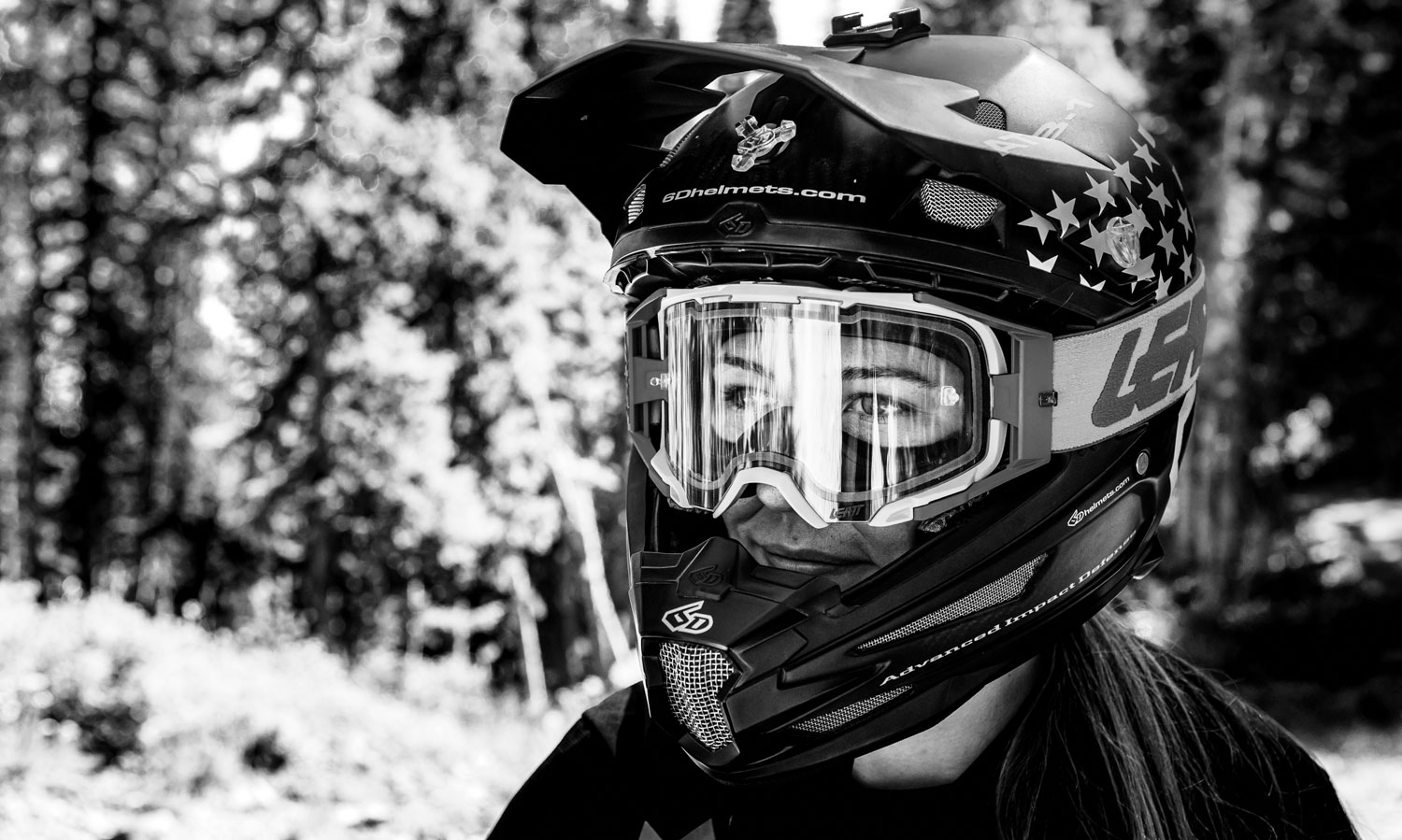
TLW: DO YOU MISS THE BMX TRACK?
JS: Sometimes I do, but I mostly miss the experiences BMX gave me. Hanging out with my friends five nights a week while having fun on my bike was so awesome, but unfortunately as things got more serious, friends began to dwindle, and sessions became more focused and less fun. I still find myself involved in BMX all the time, though. I have a coaching license through the sanction, so I train a couple of kids and I’m putting on some clinics at a new track by my house starting in a few weeks. My goals are to teach these kids to have fun and progress in all aspects of bike riding, not just on the track. I always encourage BMXers to try different disciplines of cycling, whether it’s downhill or velodrome, adapting to a different style of riding on a new bike can teach you skills you never knew you needed.
TLW: WHAT WERE YOUR FIRST IMPRESSIONS OF MOUNTAIN BIKE RACING AND THE MOUNTAIN BIKE SCENE?
JS: With my first mountain bike racing experience being at Crankworx Whistler, I could not believe how much larger the event was compared to a BMX Race and I loved how laid back everyone was. I didn’t feel judged for being a beginner and many of the top pros were much more approachable than I expected. I also never realized how many people I knew who were involved in mountain biking until I recognized someone everywhere I looked. Downhill racing wise, it was super hard for me to get the hang of not going 110 percent full pinned and I was amazed by how people didn’t crash every run. I crashed four times in my first DH race because I practiced at medium speed and tried to race at mach 5, haha. I still love how relaxed mountain biking is and how it is something entire families can enjoy at all different levels.
TLW: WHAT IS YOUR FAVORITE TYPE OF TRAIL?
JS: I love techy flow trails. I don’t like trails that are so steep and technical that I’m thinking I’m going to fall off any second, but I also don’t like super chill trails that I can ride down with no effort. I like making my own gaps over different terrains and navigating tight corners. My favorite example of this is the upper section on Angry Pirate at Whistler; I would probably never win a race on it, but I love the feeling of hitting it at my own pace and making different, fun lines every run. A bonus of Angry Pirate is that it takes you to Crab Apples, and I think everyone loves big jump trails!
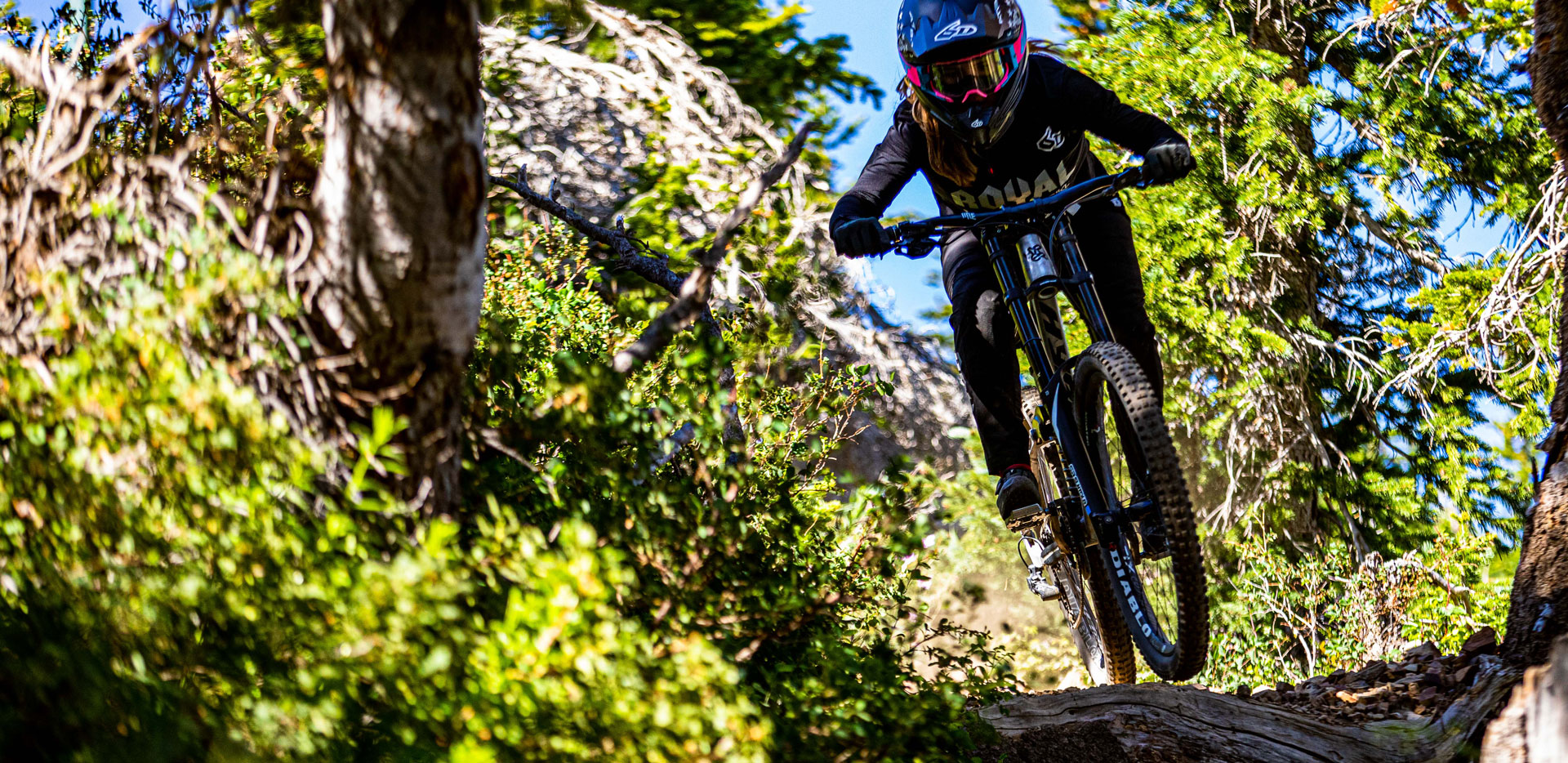
TLW: WHAT’S THE BEST PLACE YOU’VE RIDDEN SO FAR?
JS: Bike park wise, I think I have to agree with nearly everyone in the world and say Whistler. The versatility is unreal and you can always catch some laps with some sick riders. I do have to shout out Bootleg Canyon in Vegas, though. I basically learned how to actually ride my downhill bike there and it has prepared me for a lot of stuff I probably wouldn’t have been able to hit. There’s a shuttle and a tough hike to get to the top, so it isn’t ideal for doing tons of laps, but sending sketchy race runs in the off season on trails that definitely shouldn’t be raced is so much fun. If it were more accessible, I’d love to see a World Cup out there. I’ve never ridden anything like it. There’s also a shuttle trail out here in Utah called Blowhard that I’ve only ridden once, but it was insane! It is six miles of descent with maybe 200 feet of climbing and is so sick.
TLW: IF YOU COULD SHARE ONE MAJOR THING TO YOUNG RIDERS OUT THERE WHO ARE LOOKING TO GET SPONSORED, WHAT WOULD IT BE?
JS: I would say that it is important to keep in mind that the companies you are trying to get sponsored by are backed by real people and it is worth trying to make genuine relationships with them to have a strong partnership. Remember that your sponsors aren’t just strangers who give you free parts and they’re especially not ATM’s. Don’t try to be like everyone else, because they’re already sponsoring everyone else; make yourself unique and put what you bring to the table out there in the open. Try to put together a rider bio or resume that showcases your riding and results, but also who you are as a person and what you can give back to the company and the industry as a whole. Also, keep it purely fun for as long as you can!
Thanks so much for taking the time to answer these questions Jordy, we look forward to seeing you work your two-wheeled magic in person at some events next year!
To learn more about SR Suntour products, you can visit their website here.
